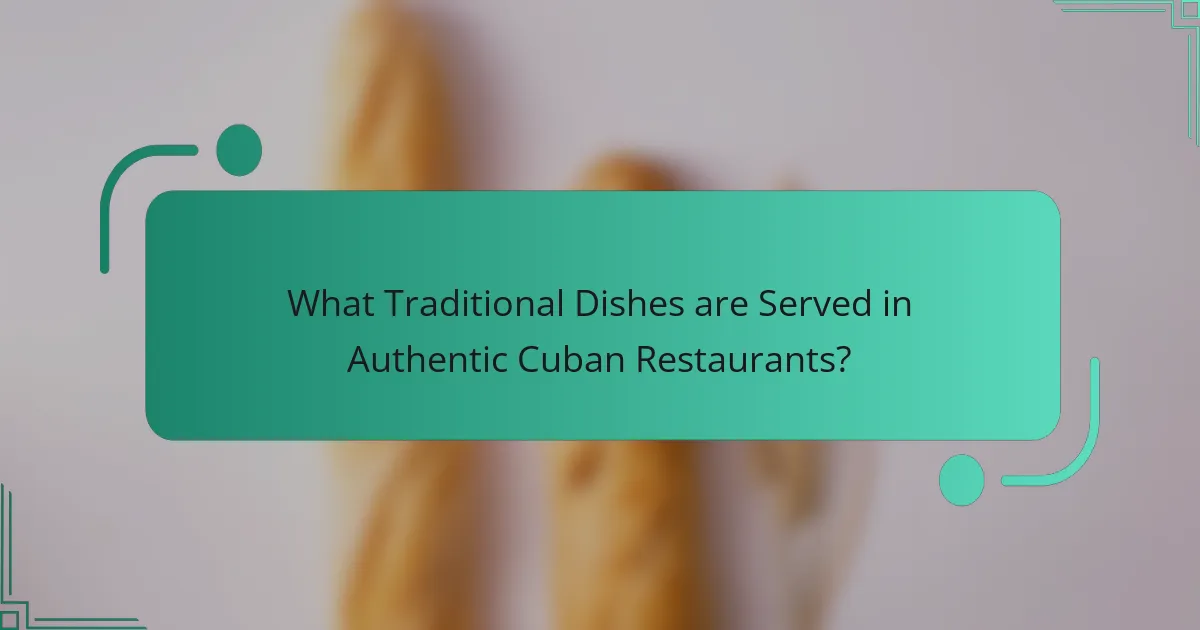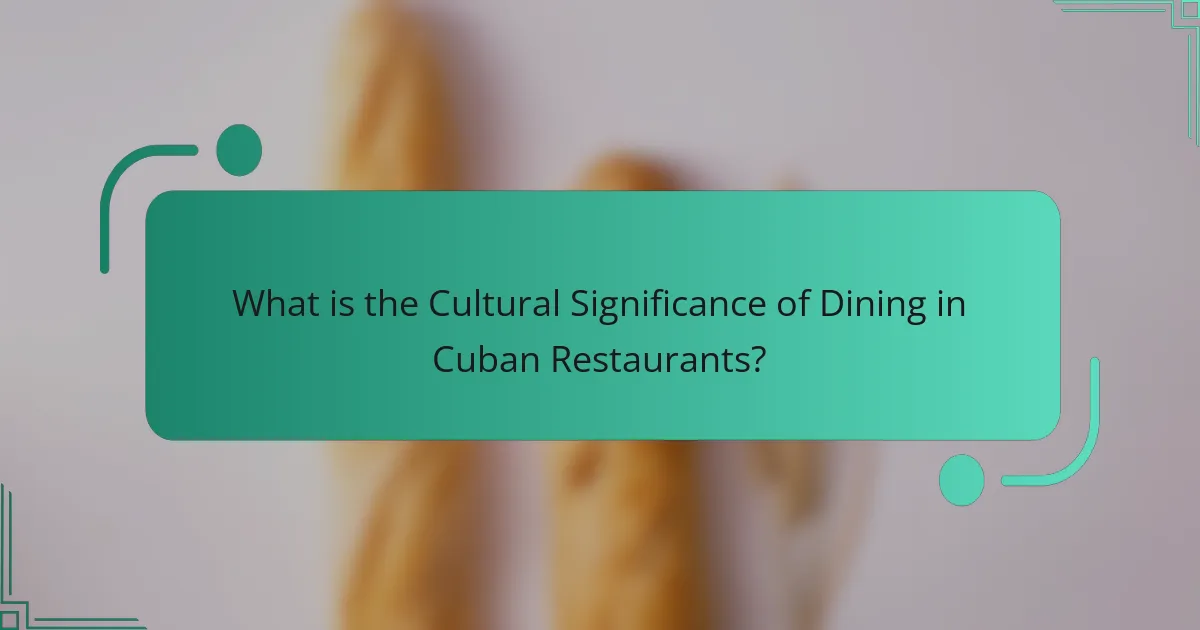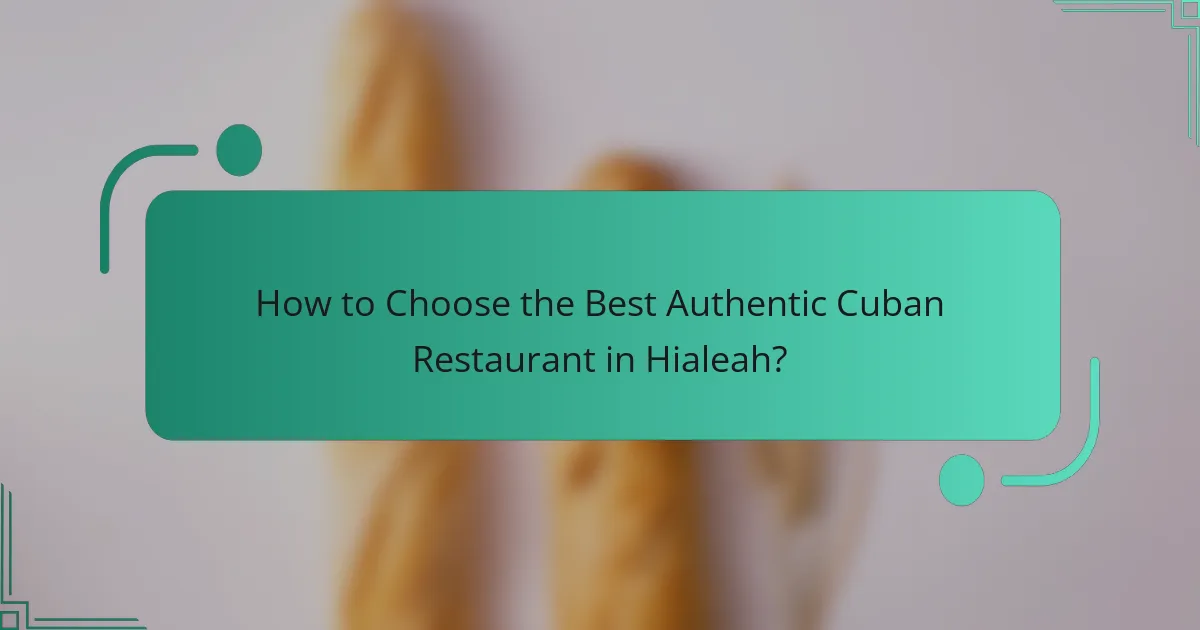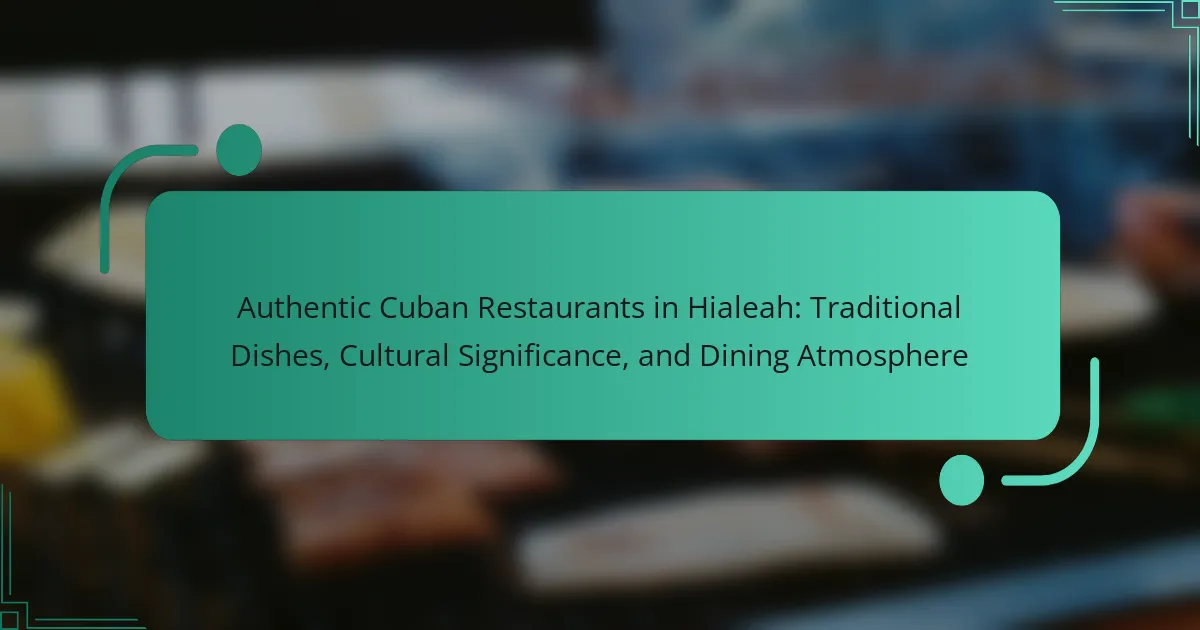Authentic Cuban restaurants in Hialeah, such as La Carreta, El Palacio de los Jugos, and Versailles, showcase traditional Cuban cuisine and cultural significance. These establishments serve classic dishes like ropa vieja, lechón asado, and yuca, reflecting Cuba’s rich culinary heritage. Dining in these restaurants emphasizes community and cultural pride, making them social hubs for families and friends. To find the best authentic Cuban restaurant, consider factors like menu authenticity, customer reviews, and the restaurant’s ambiance. This article explores the key aspects of Hialeah’s Cuban dining scene, highlighting its traditional dishes, cultural importance, and overall dining atmosphere.

What are Authentic Cuban Restaurants in Hialeah?
Authentic Cuban restaurants in Hialeah include La Carreta, El Palacio de los Jugos, and Versailles. La Carreta is known for its traditional Cuban dishes and vibrant atmosphere. El Palacio de los Jugos offers a variety of Cuban juices and classic meals. Versailles is famous for its Cuban coffee and extensive menu. These restaurants reflect the rich culinary heritage of Cuba. They serve staples like ropa vieja, lechón asado, and yuca. Each establishment emphasizes authentic flavors and cultural significance. Hialeah’s Cuban restaurants are popular among locals and visitors alike.
How do Authentic Cuban Restaurants differ from other cuisines?
Authentic Cuban restaurants differ from other cuisines primarily through their unique blend of flavors and cultural influences. They emphasize the use of fresh ingredients like garlic, citrus, and spices. Traditional dishes such as Ropa Vieja and Arroz con Pollo showcase this flavor profile. Cuban cuisine also reflects Spanish, African, and Caribbean influences, creating a distinct culinary identity. The cooking methods often include slow-cooking and marinating, enhancing the depth of flavor. Additionally, the dining atmosphere in Cuban restaurants is often vibrant and communal, reflecting the culture’s emphasis on family and social gatherings. This cultural significance sets them apart from many other dining experiences.
What defines the authenticity of Cuban cuisine?
Authenticity of Cuban cuisine is defined by its use of traditional ingredients and cooking techniques. Key ingredients include rice, beans, plantains, and various meats. These staples reflect the island’s agricultural heritage. Cooking methods often involve slow-cooking and marinating, enhancing flavors. Cultural influences from Spanish, African, and Caribbean traditions shape the cuisine’s character. Dishes like Ropa Vieja and Arroz con Pollo showcase this blend. Authentic Cuban cuisine also emphasizes communal dining and family recipes. The historical context of Cuban migration contributes to its culinary evolution.
What are the key characteristics of Cuban dining culture?
Cuban dining culture is characterized by communal meals, vibrant flavors, and rich traditions. Meals often involve sharing dishes among family and friends. Traditional foods include rice, beans, and plantains. The cuisine blends Spanish, African, and Caribbean influences. Dining is typically a lively social event, reflecting the importance of family. Music often accompanies meals, enhancing the festive atmosphere. Additionally, Cuban dining emphasizes hospitality and warmth. This culture values the experience of eating together, fostering connections among diners.
Why is Hialeah significant for Cuban cuisine?
Hialeah is significant for Cuban cuisine due to its large Cuban-American population. This city serves as a cultural hub for Cuban traditions and culinary practices. Many authentic Cuban restaurants thrive in Hialeah, offering traditional dishes like ropa vieja and lechón. The local food scene reflects the rich heritage and flavors of Cuba. Hialeah’s restaurants often use recipes passed down through generations. This culinary landscape attracts both locals and tourists seeking genuine Cuban experiences. Additionally, Hialeah hosts cultural events that celebrate Cuban food and music. This further cements its importance in preserving and promoting Cuban cuisine.
How has Hialeah’s history influenced its Cuban dining scene?
Hialeah’s history has significantly influenced its Cuban dining scene. The city’s establishment in the early 1920s attracted many Cuban immigrants. These immigrants brought their culinary traditions and recipes. The influx of Cubans intensified after the Cuban Revolution in 1959. Hialeah became a cultural hub for the Cuban community in the U.S. This led to the proliferation of authentic Cuban restaurants. Many dining establishments serve traditional dishes like ropa vieja and lechón asado. The vibrant Cuban culture is reflected in the dining atmosphere. Hialeah’s history has created a rich culinary landscape that celebrates Cuban heritage.
What role do Cuban immigrants play in Hialeah’s restaurant landscape?
Cuban immigrants are central to Hialeah’s restaurant landscape. They have established numerous authentic Cuban eateries throughout the city. These restaurants reflect traditional Cuban cuisine, showcasing dishes like ropa vieja and lechón. The culinary practices and recipes are often passed down through generations. Cuban immigrants contribute to the local economy by creating jobs and attracting customers. According to the U.S. Census Bureau, over 90% of Hialeah’s population identifies as Hispanic, primarily of Cuban descent. This demographic influence shapes the restaurant offerings and dining culture in the area. Hialeah’s restaurant scene is a vibrant representation of Cuban heritage and community.

What Traditional Dishes are Served in Authentic Cuban Restaurants?
Authentic Cuban restaurants serve a variety of traditional dishes. Ropa Vieja is a popular dish made from shredded beef in a tomato-based sauce. Arroz con Pollo features rice cooked with chicken and spices. Lechón Asado is marinated roast pork, often served during celebrations. Moros y Cristianos is a dish of black beans and rice cooked together. Tostones are twice-fried green plantains, commonly served as a side. Yuca con Mojo consists of boiled cassava topped with a garlic sauce. Vaca Frita is marinated and grilled flank steak, known for its flavor. These dishes reflect Cuba’s rich culinary heritage and cultural influences.
What are the most popular traditional Cuban dishes found in Hialeah?
The most popular traditional Cuban dishes found in Hialeah include Ropa Vieja, Arroz con Pollo, and Lechón Asado. Ropa Vieja is shredded beef cooked in a tomato-based sauce. It is often served with rice and black beans. Arroz con Pollo consists of chicken cooked with rice and saffron, creating a flavorful one-pot dish. Lechón Asado is marinated and roasted pork, known for its crispy skin and tender meat. These dishes reflect the rich culinary heritage of Cuba. Hialeah’s Cuban restaurants frequently feature these items on their menus, showcasing their cultural significance.
How is Ropa Vieja prepared and served in these restaurants?
Ropa Vieja is prepared by slow-cooking shredded beef with a blend of spices, vegetables, and tomato sauce. The beef is typically marinated before cooking to enhance flavor. Common ingredients include bell peppers, onions, garlic, and cumin. After cooking, the beef is shredded and mixed back into the sauce.
In restaurants, Ropa Vieja is served hot, often accompanied by rice and black beans. It may also be garnished with fresh herbs or avocado slices. The dish is a staple in Cuban cuisine, reflecting its cultural significance. Many restaurants take pride in their unique family recipes, adding to the authenticity of the dish.
What makes Arroz con Pollo a staple in Cuban cuisine?
Arroz con Pollo is a staple in Cuban cuisine due to its rich flavors and cultural significance. This dish combines rice and chicken, seasoned with saffron and spices. It reflects the fusion of Spanish and African culinary traditions in Cuba. The use of local ingredients enhances its authenticity. Arroz con Pollo is often served at family gatherings and celebrations. It symbolizes comfort and togetherness in Cuban culture. The dish has historical roots dating back to the colonial era. Its popularity has endured, making it a beloved choice in Cuban households and restaurants.
What unique ingredients are commonly used in Cuban dishes?
Unique ingredients commonly used in Cuban dishes include black beans, plantains, and malanga. Black beans are a staple, often served in soups or as a side. Plantains are versatile, used in dishes like tostones and maduros. Malanga, a root vegetable, adds texture and flavor to various recipes. Other notable ingredients are sour oranges, used in marinades, and spices like cumin and oregano, which enhance the dishes’ flavors. These ingredients reflect Cuba’s agricultural heritage and cultural influences.
How does the use of spices differentiate Cuban food?
The use of spices differentiates Cuban food by creating a unique flavor profile. Cuban cuisine incorporates spices like cumin, oregano, and garlic. These spices enhance the taste of traditional dishes such as Ropa Vieja and Moros y Cristianos. The combination of spices reflects the island’s diverse cultural influences, including Spanish, African, and Caribbean. For example, cumin is a staple in many Cuban recipes, adding warmth and depth. Garlic is often used to marinate meats, infusing them with rich flavor. The careful balance of spices contributes to the overall identity of Cuban food. This distinct use of spices sets Cuban cuisine apart from other Latin American cuisines.
What are the traditional cooking methods used in Cuban cuisine?
Traditional cooking methods used in Cuban cuisine include sautéing, roasting, and stewing. Sautéing is common for preparing dishes like “ropa vieja,” where meat is cooked quickly with vegetables. Roasting is often used for whole pigs during celebrations, known as “lechón asado.” Stewing is a method for dishes like “congrí,” a rice and bean combination that simmers for flavor. These methods reflect the island’s cultural influences and available ingredients. Historical practices show that these techniques have been passed down through generations, maintaining the essence of Cuban culinary traditions.

What is the Cultural Significance of Dining in Cuban Restaurants?
Dining in Cuban restaurants holds significant cultural importance as it reflects the rich heritage of Cuban cuisine and community. These establishments serve as social hubs where families and friends gather to share meals and stories. The food often features traditional ingredients and recipes passed down through generations, emphasizing the island’s agricultural roots. Cuban dining experiences frequently include lively music and vibrant decor, enhancing the cultural atmosphere. Hialeah, in particular, showcases this cultural significance through its numerous authentic Cuban restaurants. These venues contribute to the preservation of Cuban identity and traditions, fostering a sense of belonging among patrons. The communal aspect of dining in these restaurants reinforces social bonds and cultural pride within the Cuban-American community.
How do Authentic Cuban Restaurants reflect Cuban heritage?
Authentic Cuban restaurants reflect Cuban heritage through their traditional dishes, ambiance, and cultural practices. These restaurants often serve classic Cuban meals like Ropa Vieja and Arroz con Pollo. The recipes are passed down through generations, maintaining authenticity. The decor typically features vibrant colors and Cuban art, enhancing the cultural experience. Music is often played, showcasing genres like Son and Salsa, integral to Cuban identity. Additionally, these establishments foster community, serving as gathering places for families and friends. They celebrate Cuban festivals and events, further embedding cultural significance. Overall, authentic Cuban restaurants are vital in preserving and showcasing Cuban heritage.
What cultural practices are observed during meals in these restaurants?
Cultural practices observed during meals in authentic Cuban restaurants include communal dining and sharing food. Families and friends often gather to enjoy large portions of traditional dishes. Meals typically feature rice, beans, and plantains, reflecting Cuban culinary heritage. Music plays a significant role, enhancing the dining atmosphere with lively rhythms. Guests may experience a warm, welcoming environment, emphasizing hospitality. Additionally, it is common to see patrons engaging in animated conversations, showcasing the importance of social interaction during meals. These practices highlight the cultural significance of food in Cuban society.
How do Cuban restaurants contribute to community identity in Hialeah?
Cuban restaurants significantly contribute to community identity in Hialeah by serving as cultural hubs. They offer traditional Cuban dishes that reflect the heritage of the local population. These restaurants are often gathering places for families and friends, fostering social connections. They showcase Cuban music and art, enhancing the cultural experience. Additionally, many Cuban restaurants participate in community events and celebrations. This involvement strengthens local ties and promotes cultural pride. The presence of these restaurants is a testament to Hialeah’s Cuban-American identity. They help preserve and share Cuban traditions with both residents and visitors.
Why is the dining atmosphere important in Cuban restaurants?
The dining atmosphere is crucial in Cuban restaurants because it enhances the overall dining experience. A vibrant and warm atmosphere reflects the rich cultural heritage of Cuba. Elements like music, decor, and lighting create an immersive environment. This ambiance encourages social interaction, a key aspect of Cuban culture. Studies show that a pleasant atmosphere can increase customer satisfaction and repeat visits. For instance, a survey by the National Restaurant Association indicates that 70% of diners consider ambiance important when choosing a restaurant. Thus, the dining atmosphere plays a vital role in attracting and retaining customers in Cuban restaurants.
What elements create an authentic Cuban dining experience?
An authentic Cuban dining experience includes traditional dishes, vibrant atmosphere, and cultural elements. Traditional dishes such as Ropa Vieja and Arroz con Pollo are essential. These meals reflect the rich history of Cuban cuisine. A vibrant atmosphere features lively music, often including salsa or son. Decor typically includes colorful artwork and cultural symbols. Family-style dining enhances the communal aspect of the meal. Additionally, the use of fresh ingredients is crucial for authenticity. Cuban coffee served at the end of the meal is a customary practice. Together, these elements create a genuine Cuban dining experience.
How does music and decor enhance the cultural experience?
Music and decor significantly enhance the cultural experience by creating an immersive environment. In authentic Cuban restaurants, traditional music like son or salsa fills the air, evoking cultural nostalgia. This auditory backdrop invites patrons to engage with the cultural context of the cuisine. Decor elements, such as vibrant colors and traditional artwork, visually represent Cuban heritage. These design choices reflect the island’s history and artistic expressions. Together, music and decor stimulate the senses, making the dining experience more memorable. Studies show that ambient music can influence dining behavior and satisfaction. A well-curated atmosphere can evoke emotional connections to the culture being represented.

How to Choose the Best Authentic Cuban Restaurant in Hialeah?
To choose the best authentic Cuban restaurant in Hialeah, consider the menu authenticity. Look for traditional dishes like Ropa Vieja and Arroz con Pollo. Check online reviews for customer experiences regarding food quality and service. Visit during peak hours to gauge the restaurant’s popularity and atmosphere. Observe the clientele; a local crowd often indicates authenticity. Evaluate the decor and ambiance for cultural elements that reflect Cuban heritage. Research the restaurant’s history and chef background for credibility in Cuban cuisine. Lastly, consider any awards or recognitions received, as they often signify quality and authenticity.
What factors should diners consider when selecting a Cuban restaurant?
Diners should consider authenticity, menu variety, ambiance, and service quality when selecting a Cuban restaurant. Authenticity ensures the restaurant offers traditional Cuban flavors and dishes. Menu variety allows diners to experience a range of Cuban cuisine, including meats, rice, and plantains. Ambiance contributes to the overall dining experience, reflecting Cuban culture through decor and music. Service quality impacts customer satisfaction and enjoyment. These factors collectively enhance the dining experience and ensure a genuine taste of Cuban culture.
How can reviews and ratings guide your choice?
Reviews and ratings can significantly guide your choice of authentic Cuban restaurants in Hialeah. They provide insights into the quality of food and service. High ratings often indicate a positive dining experience. Reviews can highlight specific dishes that are popular among customers. They may also reveal the authenticity of the cuisine offered. Consistent positive feedback can suggest that a restaurant maintains high standards. Conversely, negative reviews can alert potential diners to issues such as poor service or lack of authenticity. Overall, reviews and ratings serve as valuable tools for making informed dining decisions.
What are some must-try dishes to order on your first visit?
Ropa Vieja is a must-try dish on your first visit. This shredded beef in tomato sauce is a Cuban classic. It is often served with rice and black beans. Another essential dish is Arroz con Pollo. This flavorful rice and chicken dish is seasoned with saffron. Lechón Asado is also highly recommended. This slow-roasted pork is marinated in a citrus-garlic sauce. Tostones, or fried green plantains, are a popular side. They are crispy and often served with garlic sauce. Lastly, try Flan for dessert. This creamy caramel custard is a traditional Cuban sweet. Each dish reflects the rich culinary heritage of Cuba.
What tips can enhance your dining experience at a Cuban restaurant?
To enhance your dining experience at a Cuban restaurant, start by trying traditional dishes like Ropa Vieja and Lechón Asado. These meals represent authentic Cuban flavors and cultural heritage. Pair your meal with a refreshing Mojito or a glass of Cuban coffee for an authentic beverage experience. Engaging with the staff can provide insights into the menu and cultural significance of dishes. Consider visiting during live music events to enjoy the vibrant atmosphere. Sharing dishes can also enhance the experience, allowing you to sample a variety of flavors. Lastly, be open to trying new ingredients and spices unique to Cuban cuisine.
How can you best appreciate the cultural aspects of your meal?
To best appreciate the cultural aspects of your meal, engage with the history and traditions behind the dishes. Research the origins of the ingredients used in Cuban cuisine. Understanding the significance of staples like rice, beans, and plantains enhances your experience. Observe the cooking methods that reflect cultural practices. For instance, many Cuban dishes are slow-cooked, showcasing culinary heritage. Additionally, interact with the restaurant staff to learn about their personal connections to the food. This dialogue can reveal stories that deepen your appreciation. Finally, embrace the dining atmosphere, which often reflects Cuban culture through music and decor, enriching the overall experience.
What etiquette should be observed when dining in these establishments?
When dining in authentic Cuban restaurants in Hialeah, observe polite table manners. Always greet the staff warmly upon arrival. Wait to be seated rather than choosing a table yourself. Place your napkin on your lap after sitting down. Speak in a moderate tone to maintain a pleasant atmosphere. When finished, place your utensils parallel on your plate to signal you’re done. Tipping is customary; 15-20% is standard for good service. These practices reflect respect for the dining experience and the culture.
Authentic Cuban restaurants in Hialeah serve traditional dishes that reflect the rich culinary heritage of Cuba, such as Ropa Vieja, Arroz con Pollo, and Lechón Asado. These establishments emphasize communal dining, vibrant flavors, and cultural significance, showcasing the influences of Spanish, African, and Caribbean cuisines. The article explores the unique attributes of these restaurants, the historical context of Hialeah’s Cuban dining scene, and the importance of dining atmosphere and cultural practices in enhancing the Cuban dining experience. Additionally, it provides guidance on selecting the best authentic Cuban restaurant, must-try dishes, and etiquette to observe while dining.



